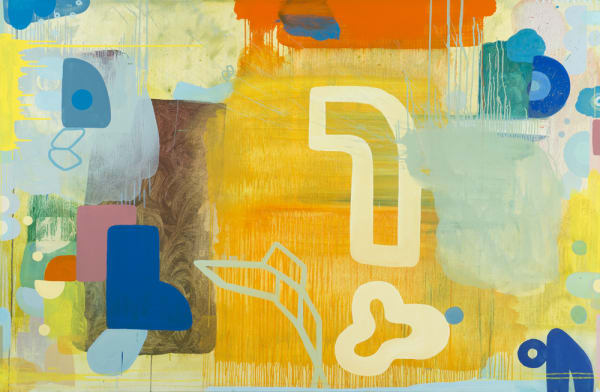The Garden of Opposites: Martin Finnin
In the course of preparing a book on my work last year I had an opportunity to think more deeply about the way I have worked over the last 25 years. It made me reflect on the way I perceive visual stimuli from my environment and how I have moved towards a style of abstraction that I consider my own. While working on the paintings for The Garden of Opposites I have been intrigued by that part of the creative process that happens in the studio: the act of painting itself and the dynamics that govern it. A painting is the result of two separate forces meeting in equal measure: technique, representing what is known, and spontaneity, representing the unknown. Technique is muscle memory. It creates a way into the canvas by building a scaffolding of paint, a structure created out of known movements and experiences. It’s never easy, nor complacent, nor quick because it always aspires to be inspired. Yet technique is when you try to stretch the painting with your brain. Technique allows me to create versions of the painting which appear painfully close to feeling finished but lack that step too far; that point which feels uncomfortable – the thing I didn’t know at the beginning which only arrives spontaneously and unasked. To resolve the piece I end up rubbing out, or overpainting, months, sometimes years, of work. Yet none of this is without purpose. Those layers of abandoned paintings are like bellows working mechanically and dutifully, building up a store of energy which will eventually, spark that moment of spontaneous combustion which will bring the whole process to an end.
In the studio you have to be obedient to time; time has total control and plays a vital, invisible role in every painting. It dictates my daily routine; it governs the technique I have to use at any given stage; it allows me to move forward only when all is ready. A painting could change dramatically simply because of the length of time it takes for a layer of oil paint to dry and the time I must wait before I can continue. On the other hand, time is the main gateway to that space of unknowing, providing that still hand on the shoulder which holds me back, which takes the painting forward by slowing the progress of work.
No brush stroke is as important as the time spent sitting with the paintings. Doing nothing but being present; then walking away and returning for another look. I sit and wait for something in my perception to change and for the pieces to unlock themselves. After each new layer, I have to allow the painting time to adapt to the change. It needs to find its equilibrium not only in the painting but also against other works in the studio. The painting has to grow on its own ¬– my natural instinct is to resist every development so that what remains has been considered and has a place, whether it stays on the surface or, over time, sinks down below.
Martin Finnin
-
 Martin Finnin, A Plum Listens to the Chaos of Thunder, 2016
Martin Finnin, A Plum Listens to the Chaos of Thunder, 2016 -
 Martin Finnin, Confessions of a Confetti Eater, 2016
Martin Finnin, Confessions of a Confetti Eater, 2016 -
 Martin Finnin, Heaven and Hell Bear no Grudge Against Passing Yellows, 2016
Martin Finnin, Heaven and Hell Bear no Grudge Against Passing Yellows, 2016 -
 Martin Finnin, More Street Cred Than Mercury, 2016
Martin Finnin, More Street Cred Than Mercury, 2016 -
 Martin Finnin, The Garden of Opposites, 2016
Martin Finnin, The Garden of Opposites, 2016 -
 Martin Finnin, The Tragedy of Romantic Diagrams, 2016
Martin Finnin, The Tragedy of Romantic Diagrams, 2016 -
 Martin Finnin, Entropy's Siblings No. 2
Martin Finnin, Entropy's Siblings No. 2 -
 Martin Finnin, Entropy's Siblings No. 3
Martin Finnin, Entropy's Siblings No. 3











